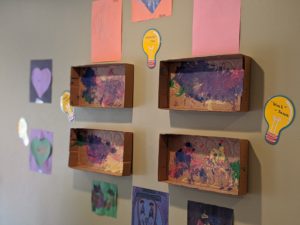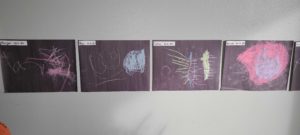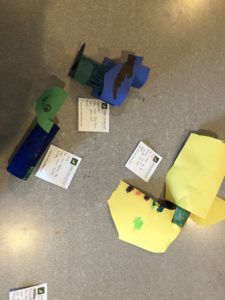Frugal Home Activity Series: Incorporating Process Art
By Jessica Abbeglen, Enrollment Coordinator

Incorporating art into your child’s at home routine is one of the most beneficial experiences you can do with your child. Art fosters creativity, self confidence, develops analytical and problem solving skills and solidifies math and science concepts. Adding art is easy and fun when you prepare and expect the mess.
When we talk about art we are NOT talking about the cute little ghosts, turkeys and reindeer, we are talking about an art experience. Many adults see art as those seasonal projects, but art really isn’t about the product, it’s about the process.
Process art is described by NAEYC:
- There are no step-by-step instructions
- There is no sample for children to follow
- There is no right or wrong way to explore and create
- The art is focused on the experience and on exploration of techniques, tools, and materials
- The art is unique and original
- The experience is relaxing or calming
- The art is entirely the children’s own
- The art experience is a child’s choice
- Ideas are not readily available online

You can use just about anything to experiment with art, even when you don’t have paint. You can soak dried up markers in cups of water to make liquid watercolors; pudding, jello, and kool aid make for fun paints, or mixing shaving cream and food coloring to make puffy paint is a fun paint substitute. You can make scented paint with spices like cinnamon, paprika, turmeric, cardamom, cocoa, or curry.
If you don’t have paint brushes; sticks, toothbrushes, forks, toothpicks and q-tips also work. Don’t forget hands are sometimes the best paintbrush!
Flour and food coloring can be mixed and painted with, then pop the painting in the microwave for a few seconds to see it puff up! Painting with q-tips on (pre-cut) coffee filters with watercolors or food coloring is a fun year round project and can be coordinated with the colors of the season.
You can glue pasta, buttons or nature items to paper, sticks, or cardboard after a nature walk. Printing with found objects, animals and vegetables is another way to learn about shapes. Newspaper or magazine cuttings added to a scrapbook can help with fine motor cutting and gluing skills. Experimenting with how different liquids soak into cardboard, or adding salt to a wet watercolor painting will change the texture of your art. Drawing on paper with white crayons before painting is a fun way to find hidden “messages.” Adding bells to the ends of paintbrushes can give you a musical sensory experience while painting.
can give you a musical sensory experience while painting.
Other tips:
- Make open ended statements or questions without judgement (i.e.good job) such as “I see you drawing a line with green, tell me about this,” “what are you going to do next?” or “what did you like about doing this?”
- Let it be. Try not to interrupt excessively and don’t ask them to do more or change something when they feel it is finished.
Just remember art is about being in the moment and enjoying the experience your child is having with the materials!